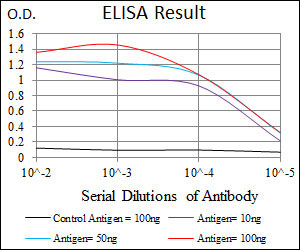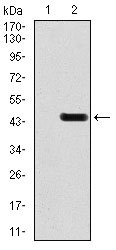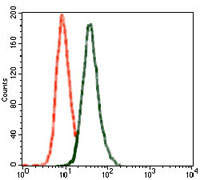GRIA2 Antibody
Purified Mouse Monoclonal Antibody
- 产品详情
- 实验流程
Application
| WB, FC, E |
|---|---|
| Primary Accession | P19491 |
| Reactivity | Human |
| Host | Mouse |
| Clonality | Monoclonal |
| Clone Names | 7G6 |
| Isotype | IgG1 |
| Calculated MW | 98688 Da |
| Description | Glutamate receptors are the predominant excitatory neurotransmitter receptors in the mammalian brain and are activated in a variety of normal neurophysiologic processes. This gene product belongs to a family of glutamate receptors that are sensitive to alpha-amino-3-hydroxy-5-methyl-4-isoxazole propionate (AMPA), and function as ligand-activated cation channels. These channels are assembled from 4 related subunits, Gria1-4. The subunit encoded by this gene (Gria2) is subject to RNA editing (Q/R and R/G), which is thought to render the channels impermeable to Ca(2+), and to affect the kinetic aspects of these channels in rat brain. Alternative splicing, resulting in transcript variants encoding different isoforms (flip and flop), has been noted for this gene. |
| Immunogen | Purified recombinant fragment of human GRIA2 (AA: 652-807) expressed in E. Coli. |
| Formulation | Purified antibody in PBS with 0.05% sodium azide |
| Gene ID | 29627 |
|---|---|
| Other Names | Glutamate receptor 2, GluR-2, AMPA-selective glutamate receptor 2, GluR-B, GluR-K2, Glutamate receptor ionotropic, AMPA 2, GluA2, Gria2, Glur2 |
| Dilution | WB~~1/500 - 1/2000 FC~~1/200 - 1/400 E~~1/10000 |
| Storage | Maintain refrigerated at 2-8°C for up to 6 months. For long term storage store at -20°C in small aliquots to prevent freeze-thaw cycles. |
| Precautions | GRIA2 Antibody is for research use only and not for use in diagnostic or therapeutic procedures. |
| Name | Gria2 {ECO:0000312|RGD:61862} |
|---|---|
| Function | Ionotropic glutamate receptor that functions as a ligand- gated cation channel, gated by L-glutamate and glutamatergic agonists such as alpha-amino-3-hydroxy-5-methyl-4-isoxazolepropionic acid (AMPA), quisqualic acid, and kainic acid (PubMed:12015593, PubMed:12730367, PubMed:15591246, PubMed:2166337, PubMed:21846932, PubMed:9351977). L-glutamate acts as an excitatory neurotransmitter at many synapses in the central nervous system and plays an important role in fast excitatory synaptic transmission (By similarity). Binding of the excitatory neurotransmitter L-glutamate induces a conformation change, leading to the opening of the cation channel, and thereby converts the chemical signal to an electrical impulse upon entry of monovalent and divalent cations such as sodium and calcium (PubMed:11773314, PubMed:12501192, PubMed:12730367, PubMed:12872125, PubMed:16483599, PubMed:1653450, PubMed:17018279, PubMed:19946266). The receptor then desensitizes rapidly and enters in a transient inactive state, characterized by the presence of bound agonist (PubMed:12015593, PubMed:16192394, PubMed:17018279, PubMed:19946266). In the presence of CACNG4 or CACNG7 or CACNG8, shows resensitization which is characterized by a delayed accumulation of current flux upon continued application of L-glutamate (PubMed:21172611). Through complex formation with NSG1, GRIP1 and STX12 controls the intracellular fate of AMPAR and the endosomal sorting of the GRIA2 subunit toward recycling and membrane targeting (PubMed:16037816). |
| Cellular Location | Cell membrane {ECO:0000250|UniProtKB:P42262}; Multi-pass membrane protein {ECO:0000250|UniProtKB:P42262} Postsynaptic cell membrane {ECO:0000250|UniProtKB:P42262}; Multi-pass membrane protein {ECO:0000250|UniProtKB:P42262}. Postsynaptic density membrane {ECO:0000250|UniProtKB:P23819}; Multi-pass membrane protein {ECO:0000250|UniProtKB:P23819}. Note=Interaction with CACNG2, CNIH2 and CNIH3 promotes cell surface expression (PubMed:19265014). Displays a somatodendritic localization and is excluded from axons in neurons (By similarity). {ECO:0000250|UniProtKB:P23819, ECO:0000269|PubMed:19265014} |
| Tissue Location | Detected in forebrain (PubMed:14687553). Detected in dendrites of neuronal cells (PubMed:9697855). Expressed in the pyramidal cell layers of CA1 and CA3 and in the granule cell layer of the dentate gyrus (PubMed:12657670). |
Research Areas
For Research Use Only. Not For Use In Diagnostic Procedures.
Application Protocols
Provided below are standard protocols that you may find useful for product applications.
REFERENCES
1.Lin Chung Er Bi Yan Hou Tou Jing Wai Ke Za Zhi. 2010 Feb;24(4):173-6. 2.Neurosci Lett. 2011 Jun 15;497(1):42-5.
终于等到您。ABCEPTA(百远生物)抗体产品。
点击下方“我要评价 ”按钮提交您的反馈信息,您的反馈和评价是我们最宝贵的财富之一,
我们将在1-3个工作日内处理您的反馈信息。
如有疑问,联系:0512-88856768 tech-china@abcepta.com.
¥ 1,500.00
Cat# AO1732a























 癌症的基本特征包括细胞增殖、血管生成、迁移、凋亡逃避机制和细胞永生等。找到癌症发生过程中这些通路的关键标记物和对应的抗体用于检测至关重要。
癌症的基本特征包括细胞增殖、血管生成、迁移、凋亡逃避机制和细胞永生等。找到癌症发生过程中这些通路的关键标记物和对应的抗体用于检测至关重要。 为您推荐一个泛素化位点预测神器——泛素化分析工具,可以为您的蛋白的泛素化位点作出预测和评分。
为您推荐一个泛素化位点预测神器——泛素化分析工具,可以为您的蛋白的泛素化位点作出预测和评分。 细胞自噬受体图形绘图工具为你的蛋白的细胞受体结合位点作出预测和评分,识别结合到自噬通路中的蛋白是非常重要的,便于让我们理解自噬在正常生理、病理过程中的作用,如发育、细胞分化、神经退化性疾病、压力条件下、感染和癌症。
细胞自噬受体图形绘图工具为你的蛋白的细胞受体结合位点作出预测和评分,识别结合到自噬通路中的蛋白是非常重要的,便于让我们理解自噬在正常生理、病理过程中的作用,如发育、细胞分化、神经退化性疾病、压力条件下、感染和癌症。










